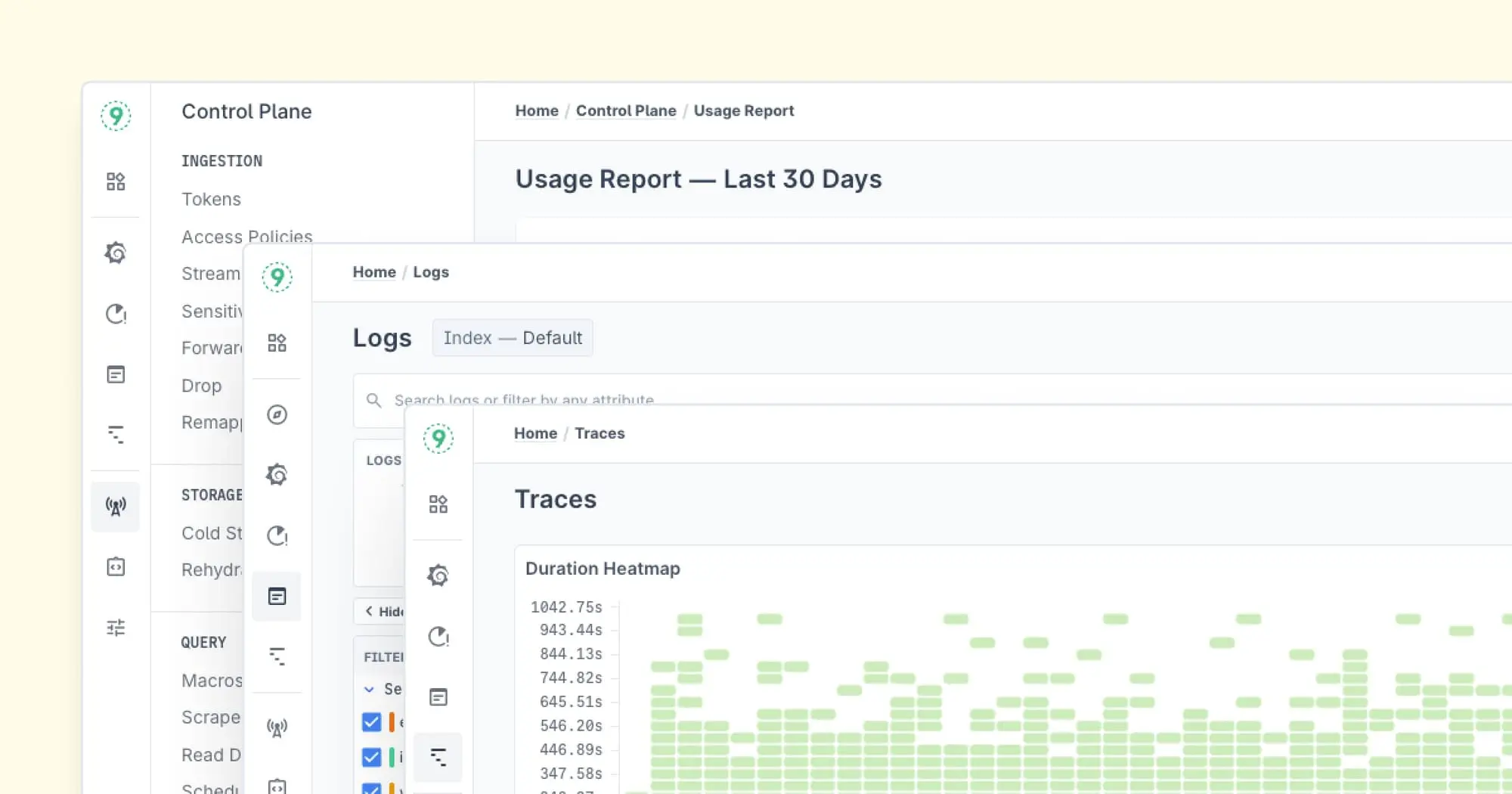Businesses rely heavily on their servers to run critical operations, manage data, and ensure seamless service delivery.
That’s why server monitoring tools have become essential to ensure your infrastructure stays up and running efficiently.
In this guide, we’ll explore server monitoring tools, why they are important for your business, and how to select the best one for your needs.
What Are Server Monitoring Tools?
Server monitoring tools are software applications designed to track and measure servers' performance, health, and availability in real-time. They provide insights into server usage metrics, such as:
- CPU load
- Memory usage
- Disk space
- Network activity
These tools help IT teams monitor server performance, detect issues before they become major problems, and optimize overall system performance.
Effective monitoring can detect server downtime, slow performance, or hardware failures, allowing teams to act swiftly and avoid costly disruptions. Server monitoring tools also offer reports and logs to analyze historical data and make informed decisions about future server needs.

Why Server Monitoring Is Essential for Businesses
Prevent Downtime
Server downtime can cripple a business. From e-commerce platforms losing sales to cloud services becoming unavailable, downtime affects revenue, customer trust, and brand reputation. With a server monitoring tool in place, businesses can proactively address issues and prevent outages before they occur.
Boost Performance
Servers are the backbone of business applications, databases, and websites. Monitoring tools track server health metrics to ensure your servers are performing at their peak. These insights help identify areas of improvement, like memory leaks or excessive CPU usage, to optimize the overall system performance.
Enhanced Security
Security is a top priority for businesses in the digital age. Server monitoring tools detect unusual activity, such as unauthorized access or malware, and alert administrators instantly. This allows you to act swiftly and mitigate any potential threats, ensuring your servers and data stay secure.
Efficient Resource Management
Server monitoring tools help you optimize resource usage. By keeping track of CPU, memory, and disk usage, you can avoid overloading your servers or running into bottlenecks. This leads to more efficient resource allocation, reducing costs and improving server performance.
Improve User Experience
A server failure can lead to a poor user experience, with slow response times or inaccessible services. By monitoring server performance, you ensure that your users have a smooth and consistent experience, leading to better customer satisfaction and retention.

Key Features of Server Monitoring Tools
When selecting a server monitoring tool, there are certain features you should look for to ensure it meets your business’s needs. Here’s a breakdown of the key features that make a server monitoring tool stand out:
Real-Time Monitoring
The ability to monitor server performance in real-time is one of the most important features. This ensures that you’re alerted instantly if any critical thresholds are breached, allowing you to take immediate action.
Customizable Alerts
Set up custom alerts based on specific conditions. Whether it's when CPU usage hits 90%, disk space runs low, or network latency spikes, having the flexibility to create tailored alerts ensures you only receive notifications that matter.
Historical Data and Analytics
The ability to review historical performance data is invaluable. By analyzing past trends, you can identify patterns, predict future server needs, and optimize resource allocation. Look for tools that offer robust analytics and reporting capabilities.
User-Friendly Dashboards
A clear, intuitive dashboard makes it easier to monitor and analyze server performance. The best server monitoring tools offer customizable, user-friendly interfaces that display critical metrics at a glance.
Automated Remediation
Some server monitoring tools offer automated remediation, meaning that when an issue is detected, the tool can automatically take corrective action. This can include restarting a service, scaling resources, or adjusting server configurations.
Multi-Server Support
If you’re managing multiple servers, ensure the tool supports multi-server environments. This will give you a centralized view of all your servers, helping you streamline monitoring efforts and improve efficiency.
Cloud and Hybrid Cloud Support
With more businesses adopting cloud and hybrid cloud environments, it’s essential to choose a server monitoring tool that can monitor both on-premises servers and cloud resources effectively.

Types of Server Monitoring Systems: Agent-Based vs. Agentless Monitoring
When it comes to server monitoring, organizations typically choose between two main types of monitoring systems: agent-based and agentless monitoring.
Both have their pros and cons and understanding the differences can help you make an informed decision about which one is right for your infrastructure.
Agent-Based Monitoring
What Is Agent-Based Monitoring?
Agent-based monitoring involves installing a software agent directly on the server you want to monitor. This agent collects data about the server’s performance, such as CPU usage, memory utilization, disk space, network traffic, and more. The data is then sent to a central monitoring system for analysis and reporting.
Advantages of Agent-Based Monitoring:
- Granular Data Collection
Since the agent resides on the server itself, it has direct access to the server’s internal metrics, allowing for detailed and real-time data collection.
This is ideal for capturing in-depth insights into the server’s performance, including custom application data and system-level metrics.
- Better for High-Frequency Monitoring
Agent-based monitoring is well-suited for environments where high-frequency data collection is needed.
The agents can continuously monitor performance without relying on external systems, ensuring minimal data loss and more accurate reporting.

- Offline Monitoring
Agents can continue to collect data even when the server is temporarily disconnected from the monitoring server.
The data will be stored locally and can be sent once the connection is re-established, making agent-based systems more resilient in case of network issues.
- Security and Customization
Since the agent resides on the server, it can be configured with custom settings, thresholds, and security configurations.
This gives IT teams the flexibility to tailor the monitoring process to the specific needs of the application and server.
Disadvantages of Agent-Based Monitoring:
- Resource Consumption
Installing and running agents on each server can consume system resources. While the overhead is generally minimal, it can be significant in resource-constrained environments, such as on low-capacity or high-density servers. - Installation and Maintenance
Setting up and maintaining agents can be time-consuming, especially in large environments with hundreds or thousands of servers. Agents need to be deployed, updated, and occasionally troubleshot, which can add to the administrative workload. - Potential for Conflicts
In some cases, agents can conflict with other software or applications on the server, particularly if the server is already running multiple processes or has strict security protocols.

Agentless Monitoring
What Is Agentless Monitoring?
Agentless monitoring, on the other hand, does not require installing any software on the target servers. Instead, it collects data remotely using standard protocols like Simple Network Management Protocol (SNMP), Windows Management Instrumentation (WMI), or Secure Shell (SSH). These protocols allow the monitoring system to communicate with the servers and gather performance metrics without needing an agent on the server itself.
Advantages of Agentless Monitoring:
- Minimal Resource Overhead
Since no agents are installed on the servers, agentless monitoring doesn’t consume additional system resources on the target machines. This can be beneficial in environments where every bit of resource utilization matters, such as on low-power devices or high-performance servers. - Simplified Deployment
Agentless monitoring is much easier to set up and scale. Since there’s no need to install or maintain agents on every server, you can quickly deploy and start monitoring multiple servers. This is especially advantageous in dynamic or large environments where rapid scaling is needed. - Less Administrative Maintenance
There are no agents to update, troubleshoot, or manage, which reduces the administrative overhead and makes agentless monitoring ideal for teams with limited IT resources or those looking for a low-maintenance solution. - Fewer Conflicts
Agentless systems avoid the risk of conflicts between monitoring agents and other software or services on the server, as no additional software components are running on the target servers.
Last9 has been crucial for us. We’ve been able to find interesting bugs, that were not possible for us with New Relic. — Shekhar Patil, Founder & CEO, Tacitbase
Disadvantages of Agentless Monitoring:
- Limited Data Granularity
Without agents on the server, the data collected may not be as granular as agent-based monitoring.
While SNMP, WMI, or SSH can provide essential server metrics, they may lack the depth of insight that agents can deliver, especially when it comes to application-level monitoring or custom metrics.
- Network Dependency
Since agentless monitoring relies on network protocols to gather data, it is vulnerable to network failures or latency.
If the network connection is disrupted, monitoring data may not be collected, leading to gaps in the performance data.
- Security Concerns
Agentless monitoring requires the server to expose certain services (such as SSH or WMI) to the monitoring system.
These services can present security risks if not properly configured and secured, as they can be potential entry points for unauthorized access.
- Limited Offline Monitoring
Unlike agent-based systems, agentless monitoring cannot continue to collect data when the server is offline.
If a server goes down or loses its network connection, no data will be gathered until it comes back online.
Choosing Between Agent-Based and Agentless Monitoring
The choice between agent-based and agentless monitoring depends on your specific monitoring needs and infrastructure requirements. Here’s a simple guide to help you decide:
- Go with agent-based monitoring if you need deep insights into server performance, especially for complex systems with custom applications or when you require high-frequency monitoring.
- Opt for agentless monitoring if you have a large, dynamic environment where rapid deployment is critical, or if you need a lightweight solution that minimizes resource consumption on servers.
In many cases, a hybrid approach that combines both agent-based and agentless monitoring may offer the best of both worlds. For example, using agent-based monitoring for critical servers and agentless monitoring for less critical ones can provide a balanced approach to server monitoring.
How to Choose the Right Server Monitoring Tool
With numerous server monitoring tools available on the market, selecting the right one can feel overwhelming. Here’s a simple process to guide you in making the best choice for your business:
Assess Your Needs
Start by evaluating your business’s server infrastructure and monitoring requirements. Do you need basic monitoring, or are you looking for advanced features like automated remediation or multi-server support? Define what’s essential for your business.
Consider Scalability
Choose a server monitoring tool that can grow with your business. If you anticipate adding more servers or expanding to the cloud, make sure the tool can scale accordingly without performance degradation.
Evaluate Integrations
Ensure the tool integrates with other systems you’re using, such as incident management platforms, ticketing systems, or log management tools. Seamless integration will streamline your workflow and reduce manual effort.
Check for Customization
Every business is unique, so flexibility is key. Look for a server monitoring tool that allows customization of dashboards, alerts, and reporting. This will enable you to tailor the tool to fit your specific needs and workflows.
Consider Cost and ROI
While budget is an important factor, don’t choose a server monitoring tool based solely on cost. Consider the value it offers in terms of uptime, performance optimization, and security. A tool that saves you time and reduces downtime can deliver a significant return on investment.
Trial and Test
Most server monitoring tools offer free trials. Take advantage of these to test the tool in your environment. This will give you a feel for the interface, features, and overall effectiveness before making a long-term commitment.

5 Popular Server Monitoring Tools to Consider
There are several top-tier server monitoring tools available that cater to different business needs. Here are a few of the most popular options:
Prometheus
A leading open-source tool designed for large-scale, cloud-native environments. Prometheus is excellent for monitoring server health, especially in distributed systems.
Last9
Designed to simplify observability, Last9 unifies metrics, logs, and traces into one cohesive view. It helps teams connect the dots across systems, improving alert management and troubleshooting.
With integrations like Prometheus and OpenTelemetry, Last9 is particularly valuable for organizations managing distributed systems and microservices architectures.

Nagios
Known for its flexibility and extensive plugin support, Nagios is a popular choice for businesses that need a customizable and comprehensive monitoring solution.
Zabbix
A powerful open-source monitoring solution for both on-premises and cloud environments. Zabbix offers a wide range of features, including real-time monitoring and advanced reporting.
Datadog
A cloud-based monitoring tool that provides deep insights into server health, performance, and security. Datadog integrates smoothly with other tools and platforms, making it a strong contender for hybrid environments.

Emerging Trends in Server Monitoring Technology
As server infrastructure evolves with the demands of modern businesses, server monitoring technology is also undergoing significant advancements. These emerging trends are reshaping how organizations monitor, manage, and optimize their servers.
Let’s explore some of the key trends in server monitoring technology:
AI and Machine Learning Integration
Artificial intelligence (AI) and machine learning (ML) are transforming server monitoring tools by enabling predictive analytics. These technologies can analyze vast amounts of data in real-time to detect anomalies and potential issues before they cause problems.
For example, AI-driven tools can identify unusual traffic patterns that might indicate a security breach or predict hardware failures based on usage trends.
Cloud-Native and Hybrid Monitoring
As businesses continue to adopt cloud technologies, the need for tools that can seamlessly monitor both on-premises and cloud-based servers is growing. Cloud-native and hybrid monitoring solutions are becoming more sophisticated, offering real-time insights into both environments.
This trend allows IT teams to manage and monitor a diverse range of resources, ensuring consistent performance across public, private, and hybrid clouds. As cloud services become more integral to business operations, hybrid monitoring strategies will become the norm, enabling teams to optimize resources across mixed environments.

Edge Computing and Distributed Systems
With the rise of edge computing, which involves processing data closer to where it’s generated (such as IoT devices), server monitoring tools are evolving to support distributed systems. These tools must handle decentralized architectures that span across multiple devices, locations, and networks.
Edge computing adds complexity to monitoring since it requires the ability to track performance across a wide array of devices and servers. As more businesses adopt edge computing, monitoring tools are adapting to offer insights into these dispersed systems, helping companies ensure smooth operations at the edge.
Serverless Architecture Monitoring
The growth of serverless computing has introduced a new paradigm in IT infrastructure. In serverless architectures, the traditional concept of dedicated servers is replaced by ephemeral functions running in the cloud.
This shift has created a need for new monitoring strategies that don’t focus on server health but instead monitor the performance of functions and services.
Serverless architecture monitoring tools are now incorporating performance tracking at the function level, providing valuable insights into execution times, latency, and resource utilization.

Unified Observability Platforms
Traditional server monitoring tools often operate in silos, focusing solely on infrastructure. However, there is a growing trend towards unified observability platforms that bring together metrics, logs, traces, and other performance data into a single, comprehensive view.
These platforms offer a holistic approach to monitoring, allowing teams to understand the full context of their system’s performance and troubleshoot issues more effectively.
The convergence of observability across all layers of infrastructure will continue to grow as businesses strive for better insights and faster problem resolution.

The Role of Technology in Server Monitoring
Technological advancements in server monitoring are not just enhancing existing features; they are fundamentally changing monitoring strategies. Here’s how these innovations are influencing how businesses approach server monitoring:
Proactive vs. Reactive Monitoring
Historically, server monitoring was reactive—IT teams would respond to issues as they arose. With AI and predictive analytics, businesses can now move toward proactive monitoring, where potential problems are detected before they impact the system.
By predicting hardware failures, performance bottlenecks, or security vulnerabilities, businesses can take action in advance, minimizing disruption and optimizing server uptime.
Automated Remediation and Self-Healing Systems
As automation and AI improve, server monitoring tools are increasingly capable of self-healing.
- When an issue is detected, these tools can automatically take corrective action, such as restarting a failed service, reallocating resources, or even adjusting configurations without human intervention.
- This reduces the manual workload for IT teams and improves response times, leading to faster issue resolution and less downtime.
Resource Optimization and Cost Efficiency
Technological advancements are enabling better resource allocation strategies.
- Server monitoring tools now allow businesses to track resource usage with greater accuracy, helping to identify inefficiencies and underutilized resources.
- This leads to more informed decisions on server provisioning, capacity planning, and scaling.
Understanding real-time resource consumption and historical trends allows organizations to optimize their infrastructure to meet demand while avoiding over-provisioning, which can lead to unnecessary costs.

Advanced Security Features
The integration of AI and machine learning has significantly boosted the security capabilities of server monitoring tools.
- These tools can now detect not only performance issues but also potential security threats, such as unusual network traffic or unauthorized access attempts.
This shift toward integrated security monitoring is a game-changer, as businesses can address both performance and security challenges simultaneously, creating a more secure and resilient infrastructure.
Capacity Planning and Resource Allocation Trends
Capacity planning and resource allocation are critical components of server monitoring, and advancements in monitoring technology are offering more accurate and actionable insights for these processes.
Here’s a closer look at how server monitoring trends are shaping capacity planning and resource allocation:
Predictive Capacity Planning
Predictive analytics is one of the most important advancements in capacity planning. Server monitoring tools equipped with AI and machine learning can analyze historical data and usage trends to predict future demand.
This predictive capability helps businesses plan for future resource needs more accurately, allowing for timely provisioning and scaling.
For instance, if a monitoring tool detects a gradual increase in traffic or workload over time, it can forecast when additional server resources will be required, enabling businesses to scale proactively.
Dynamic Resource Allocation
With the rise of cloud and hybrid environments, dynamic resource allocation has become a key strategy.
- Server monitoring tools can now automatically allocate resources based on real-time performance data.
- For example, if a server is approaching its capacity limits, the monitoring tool can trigger the provisioning of additional resources, such as virtual machines or storage, to meet demand.
This ensures that resources are used efficiently and optimally, reducing waste and improving performance.

Horizontal and Vertical Scaling Insights
Server monitoring tools are now better equipped to provide insights into both horizontal scaling (adding more servers) and vertical scaling (upgrading existing servers).
- Monitoring performance metrics across a range of servers allows these tools to identify which scaling approach will deliver the best results.
- Horizontal scaling may be the best option for distributing workloads across multiple servers, while vertical scaling might be more appropriate for handling resource-intensive applications on a single machine.
Monitoring tools help businesses make these decisions based on real-time data and usage patterns.
Cost-Effective Scaling
Effective resource allocation is not just about meeting performance demands; it’s also about controlling costs.
- Server monitoring tools can provide detailed insights into resource utilization and underused capacity, helping businesses optimize their infrastructure for cost-effectiveness.
- For example, if a server is consistently underutilized, it might be more cost-effective to downscale or consolidate workloads onto fewer machines.
Identifying such opportunities allows businesses to optimize their server costs without sacrificing performance.

Conclusion
Server monitoring tools are an essential part of ensuring your infrastructure operates smoothly. With real-time insights, custom alerts, and in-depth analytics, these tools help businesses avoid downtime, optimize performance, and maintain high-security standards.
Stay proactive and protect your business from unexpected outages—because when your servers perform well, your business performs even better.
FAQs
1. What is the difference between agent-based and agentless server monitoring?
Agent-based monitoring involves installing software agents on each server to collect detailed performance data, while agentless monitoring collects data remotely without the need for installing any agents.
Agent-based monitoring offers more granular data but can consume more resources, while agentless monitoring is lighter and easier to deploy but may lack detailed insights.
2. When should I use agent-based monitoring?
Use agent-based monitoring if you need detailed insights into server performance, especially for systems with custom applications or high-frequency monitoring needs. It’s ideal for environments where you require in-depth data, such as CPU usage, memory, disk space, and custom application metrics.
3. When is agentless monitoring a better choice?
Agentless monitoring is best for large, dynamic environments where rapid deployment is important. It’s ideal when you need a lightweight monitoring solution that minimizes resource consumption on servers and reduces administrative overhead.
4. Can I use both agent-based and agentless monitoring together?
Yes, a hybrid approach combining both monitoring types can be effective. For example, you can use agent-based monitoring for critical servers and agentless monitoring for less critical ones. This allows you to balance resource usage, deployment speed, and data granularity.
5. What are the main advantages of agent-based monitoring?
Agent-based monitoring provides granular data collection, continuous high-frequency monitoring, offline data collection, and customizable configurations for specific server needs, offering more detailed insights into server performance.
6. What are the main benefits of agentless monitoring?
Agentless monitoring has minimal resource overhead, simplifies deployment, reduces maintenance, and avoids software conflicts. It’s also ideal for environments where quick scaling and minimal administrative effort are essential.
7. Can agentless monitoring work when the server goes offline?
No, agentless monitoring cannot collect data if the server loses its network connection. Data collection resumes only once the server is back online, unlike agent-based systems that can continue collecting data offline.
8. How does network failure impact agentless monitoring?
Since agentless monitoring relies on network protocols like SNMP, WMI, or SSH, network failures or latency can disrupt data collection. If the connection is lost, performance data won’t be gathered until the network is restored.
9. Is agentless monitoring secure?
Agentless monitoring requires opening certain services like SSH or WMI on the server, which can pose security risks if not properly configured. However, these risks can be mitigated by securing network connections and ensuring proper access controls.
10. How do server monitoring tools help businesses?
Server monitoring tools provide real-time insights, custom alerts, and detailed analytics to prevent downtime, optimize performance, and enhance security. Proactively identifying issues, these tools help businesses maintain smooth operations and prevent unexpected outages.















